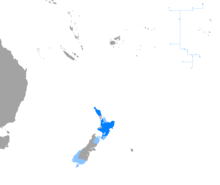Maori speaker
| Māori | |
|---|---|
| Te Reo Māori | |
| Native to | New Zealand |
| Region | Polynesia |
| Ethnicity | Māori people |
|
Native speakers
|
160,142 (2016) 148,875 in New Zealand at least conversant |
|
Latin (Māori alphabet) Māori Braille |
|
| Official status | |
|
Official language in
|
|
| Regulated by | Māori Language Commission |
| Language codes | |
| ISO 639-1 | mi |
| ISO 639-2 |
mao (B)mri (T)
|
| ISO 639-3 | |
| Glottolog | maor1246 |
| Linguasphere | 39-CAQ-a |
 |
|
Māori (/ˈmaʊri/; Māori pronunciation: [ˈmaːɔɾi] ![]() listen), also known as Te Reo ("the language"), is an Eastern Polynesian language spoken by the Māori people, the indigenous population of New Zealand. Since 1987, it has been one of New Zealand's official languages. It is closely related to Cook Islands Māori, Tuamotuan, and Tahitian. The number of speakers of the language has been in sharp decline since the end of World War II, despite a language revitalization effort.
listen), also known as Te Reo ("the language"), is an Eastern Polynesian language spoken by the Māori people, the indigenous population of New Zealand. Since 1987, it has been one of New Zealand's official languages. It is closely related to Cook Islands Māori, Tuamotuan, and Tahitian. The number of speakers of the language has been in sharp decline since the end of World War II, despite a language revitalization effort.
A national census undertaken in 2013 reported that about 149,000 people, or 3.7 per cent of the New Zealand population, could hold a conversation in Māori about everyday things. As of 2015[update], 55 per cent of Māori adults reported some knowledge of the language; but of these speakers, only 64 per cent use Māori at home and only around 50,000 people can speak the language "very well" or "well".
...
Wikipedia
